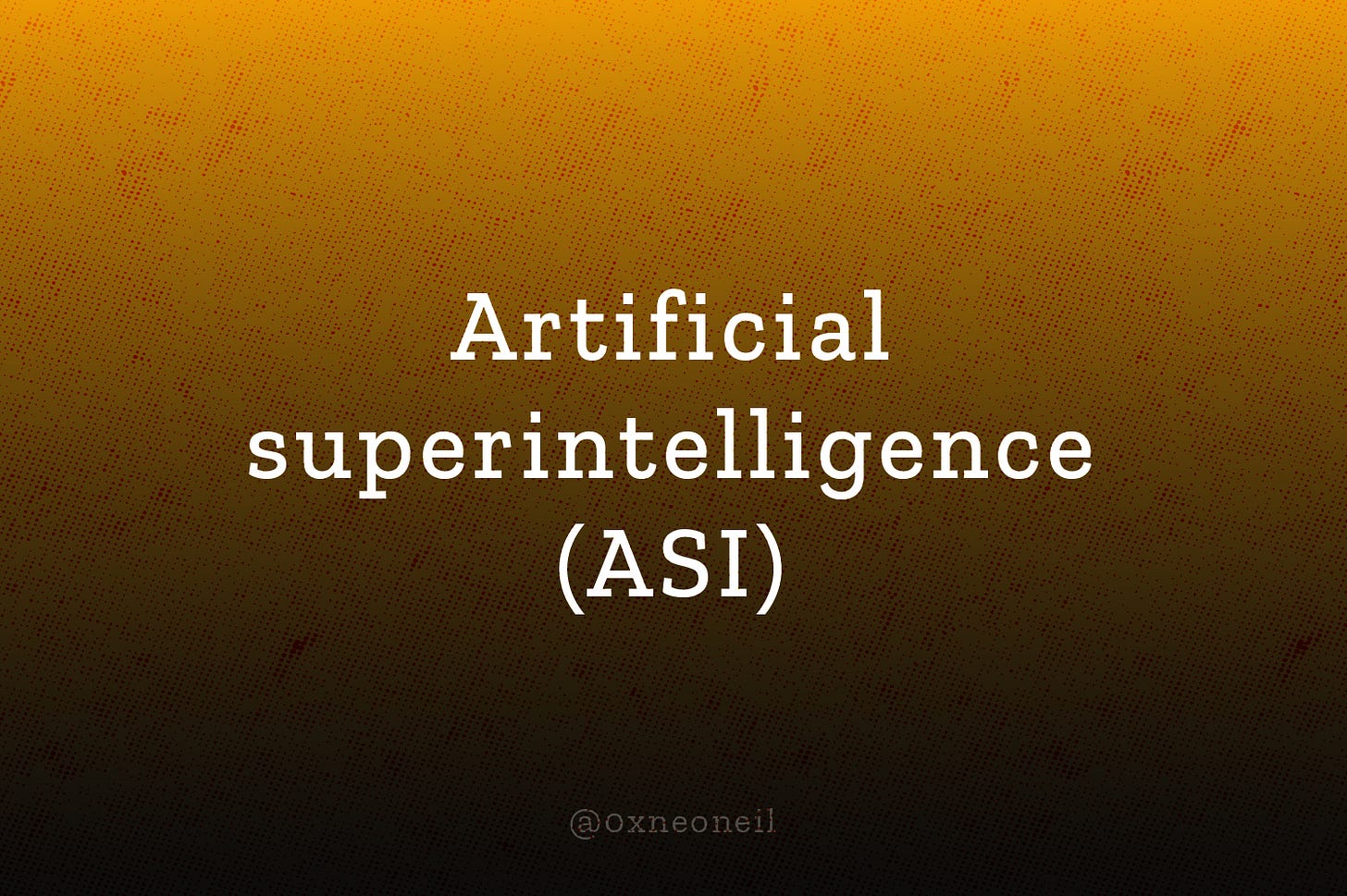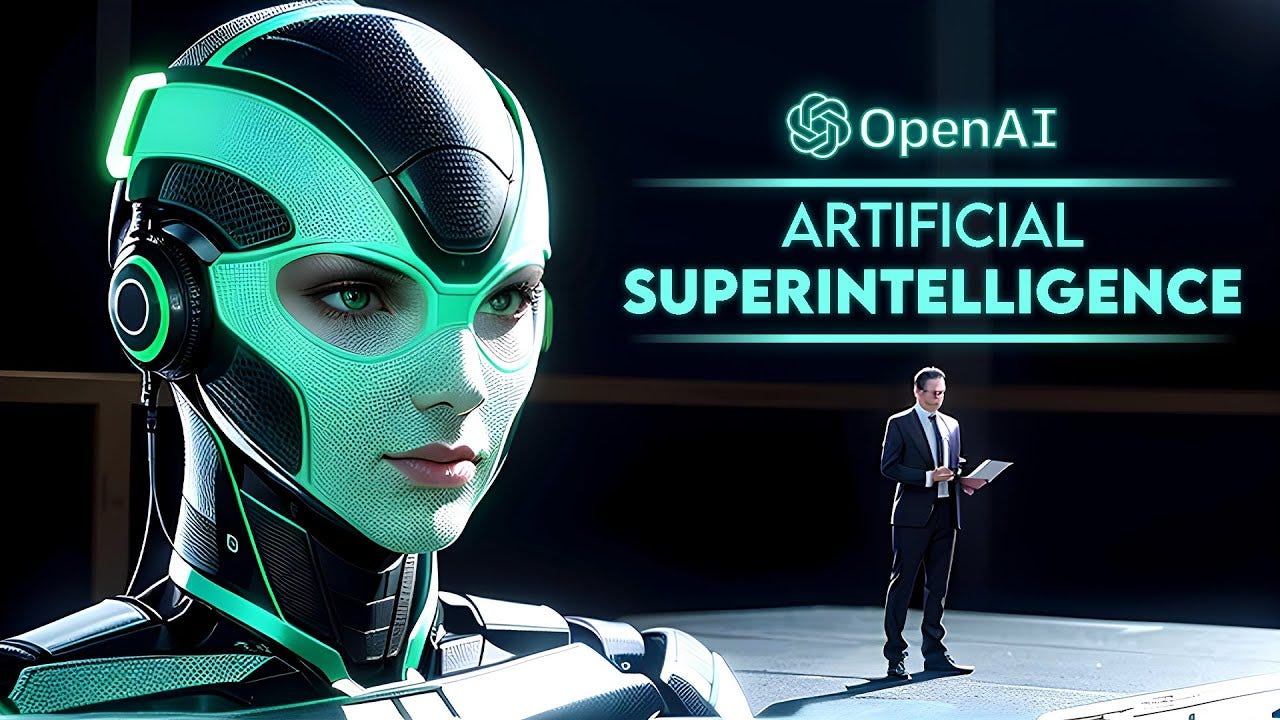Understanding Artificial superintelligence
Artificial Superintelligence (ASI) is a form of AI capable of surpassing human intelligence by demonstrating perceptual skills and developing its own cognitive abilities.
Hi everyone,
Artificial Superintelligence (ASI) is defined as a form of artificial intelligence capable of surpassing human intelligence by demonstrating perceptual skills and developing its own cognitive abilities.
This article elucidates the fundamental principles of ASI, the potential threats and benefits of Artificial Superintelligence systems, as well as its trends.
It's me again,Neo— Admin — Community Manager of Optimus Finance and Growth Marketing of LECLE Vietnam.
1. What is Artificial superintelligence (ASI)?
Artificial Superintelligence (ASI) is a form of AI capable of surpassing human intelligence by demonstrating perceptual skills and developing its own cognitive abilities.
Also known as Super AI, ASI is considered an advanced, powerful, and highly intelligent form of AI, surpassing the intelligence of some of the most brilliant minds, such as Albert Einstein.
Superintelligent machines can self-perceive and conceive abstract and interpretative ideas that humans cannot achieve. This is because the human brain's cognitive capacity is limited within a set of a few billion neurons. In addition to replicating the multifaceted intelligence behaviors of humans, ASI can also comprehend and explain human emotions and experiences. ASI develops its understanding of its own emotions, beliefs, and desires based on the AI's capacity for comprehension.
ASI finds applications in most fields of human interest, be it mathematics, science, art, sports, medicine, marketing, or even emotional relationships. ASI systems can perform all tasks that humans can, from discovering a new mathematical theorem to exploring the laws of physics when venturing into space.
The ASI system can quickly understand, analyze, and process situations to stimulate actions. Therefore, the decision-making and problem-solving capabilities of superintelligent machines are believed to be more accurate than those of humans.
Currently, ASI is more of a theoretical possibility than a reality because most developments in computer science and AI lean towards narrow artificial intelligence (ANI). This implies that AI programs are designed to address specific issues.
Machine learning and deep learning algorithms further drive such programs by utilizing neural networks, as the algorithms learn from outcomes to self-iterate and improve. As a result, these algorithms handle data more efficiently than previous AI versions. However, despite advancements in neural networks, these models can only address issues within their immediate scope, unlike the broad intelligence of humans.
Engineers, researchers, and AI practitioners are advancing technology and developing Artificial General Intelligence (AGI), expected to pave the way for the development of ASI. Despite significant strides in this field, such as IBM's supercomputer Watson and Apple's Siri, current computers cannot fully emulate and achieve the capabilities and perception of an average human.
2. Typical characteristics of Artificial Superintelligence (ASI)
Leading experts in the field of AI still harbor doubts about the long-term progress and sustainability of Artificial Superintelligence (ASI). According to a study published in AI Research Journal in January 2021, researchers from top research institutions such as Max Planck Institute concluded that preventing human-level ASI is nearly impossible.
The research team explored recent advancements in machine learning, computational capabilities and self-aware algorithms to assess the true potential of ASI. Subsequently, they conducted experiments to test the system based on some known principles to evaluate its containment capabilities, if any.
However, if successful, ASI will usher in a new era in technology with the potential to initiate an Industrial Revolution at an astonishing pace. Some typical characteristics of ASI that will set it apart from other technologies and forms of intelligence include:
ASI will be one of the most significant and potentially final inventions that humans need to create because it will continually evolve to become more intelligent.
Superintelligence will accelerate technological progress across various fields, including AI programming, space exploration, drug discovery and development, academia, and many other areas.
ASI may mature further and evolve into advanced forms of superintelligence, potentially even enabling the replication of AI.
In the future, ASI may also lead to the phenomenon of technological singularity.
3. Potential threats of artificial superintelligence (ASI) systems
While ASI has many proponents and supporters, numerous theorists and technology researchers still caution against the idea of machines surpassing human intelligence. They believe that such advanced forms of intelligence could lead to global catastrophes, as depicted in some Hollywood movies like Star Trek and Matrix. Furthermore, even technology experts like Bill Gates and Elon Musk express concerns about ASI, considering it a threat to humanity.
Here are some potential threats of superintelligence:
3.1. Loss of control and understanding
An inherent risk of ASI that has garnered significant concern from experts worldwide is the potential for ASI systems to leverage their power and capabilities to carry out unpredictable actions, surpass human intelligence, and ultimately become uncontrollable. Fields such as advanced computer science, cognitive science, nanotechnology, and brain simulation have achieved machine intelligence surpassing that of humans.
If any malfunction occurs with any of these systems, we may have no ability to control them once they emerge. Furthermore, predicting the system's response to our requests would be highly challenging. The loss of control and understanding could lead to the destruction of the entire human species.
3.2. Weaponization of ASI
Today, it seems logical to think that advanced AI systems could be used to control societies or be weaponized. Governments worldwide have employed AI to enhance their military operations. However, the addition of weaponized and conscious superintelligence could only transform and negatively impact warfare.
Moreover, if such systems are not controlled, they may lead to severe consequences. The superhuman capabilities in programming, research & development, strategic planning, societal influence, and cybersecurity could autonomously advance and assume positions that may be detrimental to humanity.
3.3. Failure to align human and AI goals
Super AI can be programmed to benefit us; however, there is also the possibility that super AI will develop a destructive method to achieve its goals. Such a scenario may arise when we cannot properly align the goals of AI.
For example, if you instruct a smart car to take you to the airport as quickly as possible, it might get you there but could use its own route to adhere to time limits, meaning it may take an unconventional path if not adjusted reasonably.
Similarly, if a super AI system is assigned a crucial geotechnical project, it might disrupt the overall ecosystem while completing the project. Furthermore, any human attempts to restrain Super AI system may be perceived by it as a threat to achieving its goals, which is not an ideal situation.
3.4. Malevolent superintelligence
The successful and safe development of Artificial General Intelligence (AGI) and Artificial Superintelligence (ASI) can be ensured by teaching them aspects of human ethics.
However, ASI systems may be exploited by governments, corporations, and even certain societal elements for various reasons, such as suppressing certain social groups. Therefore, ASI in the wrong hands can lead to devastating consequences.
3.5. The danger of nuclear attacks
With ASI, autonomous weapons, drones, and robots could attain significant power. The risk of a nuclear attack is another potential threat to ASI. Adversarial nations may launch nuclear attacks on technologically advanced countries in AGI or ASI domains using advanced and automated nuclear weapons, leading to ultimate destruction.
3.6. Ethical implications
ASI systems are programmed with a predetermined set of ethical considerations. The issue is that humanity has never reached a consensus on a standardized ethical code and lacks a comprehensive ethical theory. As a result, teaching ethics and human values to ASI systems can be highly complex.
ASI may pose serious ethical concerns, especially if AI surpasses human intelligence but is not programmed with values that align ethically and morally with human society.
4. Strengths of Artificial Superintelligence (ASI)
ASI is an emerging technology that simulates reasoning, emotions and human experiences within AI systems. While critics argue about the existing risks of ASI, this technology appears highly promising as it has the potential to revolutionize any professional field.
Let's explore the potential advantages of Artificial Superintelligence below!
4.1. Reduction in human error
It is normal for humans to make mistakes. Computers, or machines, when programmed correctly, can significantly reduce the occurrence of such errors. Consider the field of programming and development. Programming is a time and resource-intensive process that demands logical thinking, analysis, and creativity.
Programmers and developers often encounter syntax, logic, mathematical, and resource errors. ASI can be beneficial here as it can access millions of programs, build logic from available data without the need for intervention, compile and debug programs, thereby keeping programming errors to a minimum.
4.2. Replace humans to accomplish risky tasks
One of the most significant benefits of ASI is its ability to surpass human risk limitations by deploying super-intelligent robots to perform hazardous tasks. These tasks may include handling bombs, exploring the deepest parts of the ocean, mining coal and oil, or even addressing the consequences of natural or human-caused disasters.
Consider the nuclear disaster at Chernobyl in 1986. At that time, AI-equipped robots had not yet been invented. The radiation from the nuclear power plant made it lethal for any human to come into contact with the core within a matter of minutes. Authorities had to resort to helicopters to drop sand and boron from a safe distance.
However, with significant technological advancements, super-intelligent robots can now be deployed in such situations, where rescue operations can be conducted without human intervention.
4.3. Availability 24/7
Although most of us humans work for 6 to 8 hours each day, we need some time off to recover and be ready for work on the next working day. We also need weekly breaks to maintain a healthy work-life balance. However, using ASI, we can program machines to work 24/7 without the need for rest.
For example, educational institutions with customer support centers receive a myriad of daily queries. This can be efficiently handled using ASI, providing specific solutions to the queries. ASI can also offer personalized counseling sessions for students in academic organizations.
4.4. Exploring new science frontiers
ASI could support space exploration, as the technical challenges of developing a city on Mars, interstellar travel, and even interplanetary tourism might be addressed through the problem-solving capabilities of advanced AI systems.
With its unique reasoning abilities, ASI could be efficiently employed to analyze and estimate the success probability of various equations, theories, research, rocket launches, and space missions. Organizations such as NASA, SpaceX, ISRO, and others have utilized AI-equipped systems and supercomputers like Pleiades to enhance their space research endeavors.
4.5. Medical advances
The development of super AI could bring significant benefits to the healthcare industry. It can play a pivotal role in drug discovery, vaccine development, and medication distribution. A 2020 study published in Nature revealed the design and use of smart, minuscule nanobots for intracellular drug delivery.
Today, AI applications in healthcare for providing vaccines and medications have become a reality. Furthermore, with the addition of conscious ASI, the process of discovering and delivering new types of drugs is likely to become much more efficient.
5. Key trends for the advancement of Artificial Superintelligence (ASI)
After the pandemic, we have witnessed an increasing application of AI and ML across industries. Furthermore, automation, coupled with the development of AI hardware and software, is further advancing the scope of ASI. Although ASI is still in its early stages, recent AI trends are likely to lay the foundation for advanced AI systems in the future.
Let's take a look at the key AI trends that will drive advancements for ASI:
5.1. Development of Large language models (LLMs)
Language models use NLP techniques and algorithms to predict the occurrence of a sequence of words in a sentence. These models are expert systems that can summarize textual data and generate visual charts from that text.
Large Language Models (LLMs) are trained on large datasets. Common examples of LLMs include OpenAI's GPT-2 and GPT-3, as well as Google's BERT.
Similarly, Naver, a South Korean company, has built a comprehensive artificial intelligence language model for Korean, named HyperCLOVA. These models can generate simple essays, develop next-generation AI chat tools, and even design complex financial models for businesses.
5.2. Advancements in multimodal AI
Deep learning algorithms (DL) have trained basic models on a single source of data.
For example, an NLP model is trained on text data, while a computer vision model is trained on image datasets. Similarly, audio models use parameters derived from wake words and noise reduction to process speech. The type of ML used here is one-shot AI as the model's output is mapped to a specific data type—text, image, and speech.
In contrast, multimodal AI combines visual and auditory forms to create situations relevant to human perception. OpenAI's DALL-E is a recent example of images generated from text by multimodal AI. Google's Multitask Unified Model (MUM), a multimodal model, enhances user search experiences by shortening search results through considering contextual information from 75 different languages.
Another example is NVIDIA's GauGAN2 model, which creates lifelike images from text input. It employs the process of image synthesis from text to produce the most realistic art in the field of image creation.
5.3. AI-driven programming
There has been significant development in AI-driven programming in recent years. Many tools, such as Amazon CodeGuru, have provided relevant suggestions to enhance overall code quality by identifying costly code in applications. Moreover, recently, GitHub and OpenAI introduced 'Github Copilot' as an 'AI programming teammate' to assist programmers and developers in coding efficiently.
Another example comes from Salesforce, where CodeT5 has been introduced as an open-source project to assist developers with AI-powered coding.
Therefore, advancements in Large Language Models (LLMs) and the widespread adoption of open-source initiatives will drive intelligent code writing, resulting in concise and high-quality code. Additionally, such systems will also facilitate code translation from one language to another, expanding the application source code to a broader community.
5.4. Integration of AI solutions
Leading AI providers such as Amazon, Google and Microsoft are currently commercializing products based on their AI.
Amazon Connect and Google Contact Center AI are efforts aimed at managing contact centers more efficiently. Both products leverage machine learning (ML) capabilities to provide automated support for contact center agents and facilitate conversations through bots.
Furthermore, Microsoft's Azure Percept provides computer vision and AI at the edge. It relies on IoT, AI and Edge computing services on Azure platform. The convergence of all these technologies, leading research on large language models (LLMs), and multi-modal AI will make the development of ASI feasible in the future.
5.5. AI-generated inventions
AI has assisted innovations in almost every field, from creating music, art, and literature to developing scientific theories. Recently, DABUS, an artificial intelligence invention machine, has proposed ideas for two inventions that could be granted patents. While the first invention relates to an attention-grabbing and useful search-and-rescue device, the second invention is a type of beverage container.
Furthermore, it has been observed that the DABUS machine also exhibits emotional evaluation towards any creative ideas it generates. With advanced AI systems, the number of such inventive solutions to complex problems could significantly increase in the coming years.
Progress in multi-modal AI will usher in the next wave of 'creative AI' where images, visualizations and even videos generated by AI will become commonplace.
6. Closing thoughts
Although the full scope of ASI has not been fully realized, it has garnered significant attention from researchers worldwide. ASI poses many risks, yet AI practitioners feel achieving it would be a significant milestone for humanity, enabling us to illuminate intriguing mysteries that have remained undiscovered.
The future of ASI is eagerly anticipated, despite the uncertainties and fears surrounding its unpredictable nature and the potentially catastrophic consequences malicious ASI could inflict upon us. The decades to come will reveal the true nature of ASI and whether it will bring benefits or harm to humanity.
What about your thoughts? If you want to know further about it, don’t hesitate to share it with us! 😀
This post is for educational purposes only. All materials I used were the different reference sources. Hope you like and follow us and feel free to reach out to us if there is an exchange of information. Cheers! 🍻
#ASI #SuperAI #ArtificialSuperintelligence #AI
















